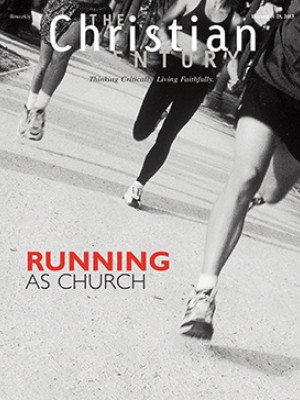Sunday, December 29, 2013: Matthew 2:13-23; Isaiah 63:7-9
When my mother visited my church for the first time, a woman greeted her during the passing of the peace. Realizing that she was speaking to the pastor’s mother, the woman asked, “Just how many children do you have?”
“Six,” my mom responded. Then she hastily corrected herself. “Well, five who are living.” As she turned to the next person her eyes filled with tears.
Her firstborn, my oldest brother, drowned more than 50 years ago. Aside from a fading baby picture and a pair of copper-glazed baby shoes, one could know our family fairly well without ever hearing about my brother’s short life. Yet sometimes the pain is so fresh, so very real, that the most benign of questions can cause my mother to relive it at random moments—like during the passing of the peace in her daughter’s church.
“A voice was heard in Ramah, weeping and great mourning . . . Rachel refusing to be comforted because her children are no more.” It’s an eternal pain, an eternal wail.
Jesus’ life began with a father who managed to save his own son yet had to live the rest of his life knowing that scores of other infant sons had died. Mary’s deep relief for her own son’s safety had to exist alongside her grief for the suffering caused by Herod’s decree.
Read our latest issue or browse back issues.
As families recounted the story of the massacred children in the years that followed, mothers must have wondered how Jesus bar Joseph had managed to escape. I imagine Joseph reliving his dream and the angel’s visitation and asking himself if he had missed something. When the angel said, “Take your son,” was there an expectation that Joseph would convey a warning?
Like most pastors I tremble when attempting to preach these post-Christmas texts. Some years I want to retreat from the implications that this infant genocide has for the present-day afflictions of the world. Yet wherever I turn, these texts force me to look directly into the faces of those I want to flee. I see Matthew lining up the sad wailing echoes of Moses’ life reinterpreted in the life of the Son of God, and Herod and his Rome as yet another example of the despotic regime of Pharaoh and his slave labor camp of Hebrews. Once again the groaning of the people reaches the Lord’s ears and the Lord is moved to action.
From the beginning Jesus’ birth demands that we take seriously the suffering of the world and our place in the midst of it. We must bear the double meaning of the event: the safety of the Savior, but who is held in the hands of a dad and a mom who heard the wails of the Rachels around them.
The Isaiah texts are a powerful image to pair with Rachel’s wails, but we have to look at their context. The narrow lectionary readings are a word of dogged hope that emerges as Isaiah, imagining the day of the Lord’s vengeance, sees an approaching warrior. But this is a warrior they would barely recognize. His clothes are so stained from the blood of battle that he is likened to a farmer who got into a winepress to smash his own grapes—the cotton fibers of his tunic absorbing the deep purple of the splattering juice.
There’s no mistaking this soldier for a commander who sits mounted on his horse observing the battle from afar. This one has robes soaked with blood. Is it his own blood? The blood of others? We don’t know. But we know that he was close enough to the battle to experience what the fallen around him experienced, to hear their last gasps of life and their groans of death.
As I enjoy my stuffed, post-Christmas state, I may find it hard to remember a suffering world. My children will be home, and we’ll have home-baked goodies from my congregation’s cooks. We’ll celebrate the goodness of the Lord.
But we can’t avoid the suffering. These texts were a powerful comfort for many after the 2004 tsunami that killed more than 220,000 people, or in December 2012 after the murder of innocents at an elementary school. In the days after the Sandy Hook shootings a colleague put a Mr. Rogers quote on her door: “When I was a boy and I would see scary things in the news, my mother would say to me, ‘Look for the helpers. You will always find people who are helping.’”
In those horrific moments our hearts know the truth of these biblical texts: where suffering is, Jesus is. And where Jesus is, his body, the church, is found as well. The people of Christ are bandaging, comforting, healing, protecting and soothing. They are the helpers.
Isaiah realized that salvation came not through an angel or messenger, but through the Lord’s very presence. It’s with this image in his head that Isaiah clings to the “loyal love of Yahweh,” recalling again all of the goodness his people have known at the hands of the Lord. It was in the community of God’s people that the prophet saw and felt the goodness of the Lord.
Perhaps that’s why my mother found herself tearing up in an unfamiliar church with people she didn’t know. While the peace-passers were strangers to her individually, they were known to her collectively. We are a community where the eternal wail of pain can be voiced. In these sacred spaces the praises of the people become deep-throated expressions of dogged trust and hope. We wait for the coming day of salvation, when pain and joy, uncertainty and trust, woes and wonder are all absorbed in the presence of God.





